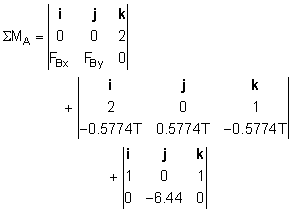| Ch 5. Rigid Body Equilibrium | Multimedia Engineering Statics | ||||||
|
2-D and 3-D Supports |
Equilibrium in 2-D |
Equilibrium in 3-D |
Indeterminate Objects | 2 and 3 Force Members | |||
| Equilibrium in 3-D | Case Intro | Theory | Case Solution |
| Chapter |
| 1. Basics |
| 2. Vectors |
| 3. Forces |
| 4. Moments |
| 5. Rigid Bodies |
| 6. Structures |
| 7. Centroids/Inertia |
| 8. Internal Loads |
| 9. Friction |
| 10. Work & Energy |
| Appendix |
| Basic Math |
| Units |
| Sections |
| eBooks |
| Dynamics |
| Fluids |
| Math |
| Mechanics |
| Statics |
| Thermodynamics |
| ©Kurt Gramoll |
|
|
||
|
The process for analyzing a rigid body in equilibrium subject to a 3-D system of forces is similar to that of a 2-D system of forces. Begin by drawing a free-body diagram. To use the equilibrium equations, the tension in the rope must be expressed in terms of its rectangular components. Using the coordinates of points D and E, the position vector from D to E is rDE = rAE - rAD = (1i + 1j + 0k) - (2i + 0j + 1k) rDE = -1i + 1j - 1k Divide rDE by its magnitude to get a unit vector that is parallel to the axis of the rope. uDE = -0.5774i + 0.5774j - 0.5774k Use this unit vector to express the tension in the rope in terms of rectangular components: |
|
T = T uDE = T ( -0.5774i + 0.5774j - 0.5774k) Using the equilibrium equations, sum the forces, ΣFx
= FAx + FBx - 0.5774 T = 0 (1) Next, sum the moments about point A. This will will give a vector equation representing moments around all three axis that go through A, x-axis, y-axis, and z-axis. ΣMA
= rAB × FB
+ rAD × T ΣMA
= (-2FBy - 0.5774 T + 6.44)i ΣMx
= -2FBy - 0.5774 T + 6.44 = 0 (4) Solving Eqs. 1-6 simultaneously gives the components of reaction in each support, and the tension in the rope. FAx = 4.830 lb |
||



